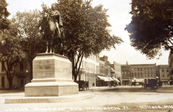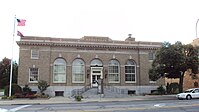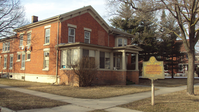
Monroe County is a county in the U.S. state of Michigan. As of the 2020 Census, the population was 154,809. The largest city and county seat is Monroe. The county was established as the second county in the Michigan Territory in 1817 and was named for then-President James Monroe.
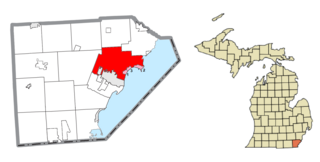
Frenchtown Charter Township is a charter township within Monroe County in the U.S. state of Michigan. The population was 20,428 at the 2010 census.

Maybee is a village in Monroe County in the U.S. state of Michigan. The population was 545 at the 2020 census. The village is located within Exeter Township. Maybee was established in 1873 and incorporated as a village in 1899.

Monroe is the largest city and county seat of Monroe County, Michigan, United States. The population was 20,462 as of the 2020 census. The city is bordered on the south by Monroe Charter Township, but the two are administered autonomously. Monroe is the core city in the Monroe metropolitan area, which is coterminous with Monroe County and had a population of 154,809 in 2020. Located on the western shores of Lake Erie approximately 14 miles (23 km) north of Toledo, Ohio and 25 miles (40 km) south of Detroit, the city is part of the Detroit–Ann Arbor–Flint combined statistical area.

Raisinville Township is a civil township of Monroe County in the U.S. state of Michigan. The population was 5,816 at the 2010 census.

The River Raisin is a river in southeastern Michigan, United States, that flows through glacial sediments into Lake Erie. The area today is an agricultural and industrial center of Michigan. The river flows for almost 139 miles (224 km), draining an area of 1,072 square miles (2,780 km2) in the Michigan counties of Lenawee, Washtenaw, Jackson, Hillsdale, and Monroe County, where its mouth at Lake Erie is located. French settlers named it as La Rivière aux Raisins because of the wild grapes growing along its banks, the French word for grape being raisin. The French term for "raisin" is raisin sec.
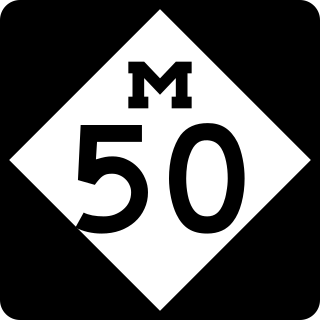
M-50 is a state trunkline highway in the US state of Michigan. Although designated as an east–west highway, it is nearly a diagonal northwest–southeast route. The western terminus is at exit 52 along Interstate 96 (I-96) near Alto a few miles east of the metro Grand Rapids area, and its eastern terminus is in downtown Monroe at US Highway 24. In between the trunkline runs through seven counties of the southern part of the Lower Peninsula mostly through rural farm fields and small communities. The highway also runs through downtown Jackson to connect between two freeway sections of US 127. In the Irish Hills area of the state southeast of Jackson, M-50 runs next to Michigan International Speedway.

Sandy Creek is an 18.5-mile-long (29.8 km) creek located entirely within Monroe County in the U.S. state of Michigan. The creek rises in London Township in the north-central portion of the county and flows southeast into Lake Erie in Frenchtown Charter Township at Sterling State Park.
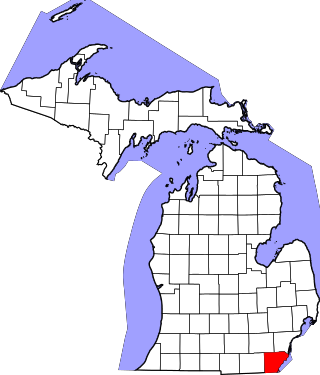
This is a list of the National Register of Historic Places listings in Monroe County, Michigan.

The River Raisin National Battlefield Park preserves the site of the Battle of Frenchtown as the only national battlefield marking a site of the War of 1812. It was established as the 393rd unit of the United States National Park Service under Title VII of the Omnibus Public Land Management Act, which was signed into law on March 30, 2009. The park is located in the city of Monroe in Monroe County, Michigan. It was designated as a Michigan Historic Site on February 18, 1956 and was added to the National Register of Historic Places on December 10, 1982. The house at 1403 East Elm Avenue was added to the National Register listing in 2019. It officially began operation as a national park unit on October 22, 2010.

The George Armstrong Custer Equestrian Monument, also known as Sighting the Enemy, is an equestrian statue of General George Armstrong Custer located in Monroe, Michigan. The statue, sculpted by Edward Clark Potter, was designated as a Michigan Historic Site on June 15, 1992 and soon after listed on the National Register of Historic Places on December 9, 1994.
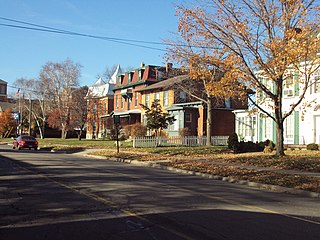
The East Elm–North Macomb Street Historic District is a residential historic district located in the city of Monroe in Monroe County, Michigan. The district was listed as a Michigan Historic Site and added to the National Register of Historic Places on May 6, 1982.

The Governor Robert McClelland House is a private residence located at 47 East Elm Avenue in the city of Monroe in Monroe County, Michigan. It was listed as a Michigan Historic Site on March 3, 1971, and it was the first property in the county to be listed on the National Register of Historic Places on September 3, 1971.

The Sawyer House, also known as the Sawyer Homestead and in its previous incarnation as the Navarre House, is a city-owned house located at 320 East Front Street in Monroe, Michigan. It was listed as a Michigan Historic Site on June 19, 1975. The house was listed on the National Register of Historic Places on November 23, 1977, and is also part of the larger Old Village Historic District.
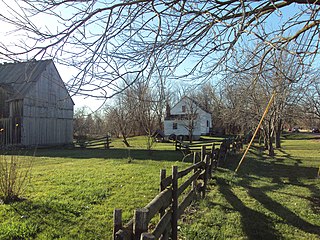
The Navarre–Anderson Trading Post is a former trading post complex located at 3775 North Custer Road in Frenchtown Charter Township along the River Raisin in Monroe County, Michigan. It was listed as a Michigan Historic Site on June 16, 1972 and also listed on the National Register of Historic Places on July 31, 1972.

The St. Mary's Church Complex Historic District is a historic district located at the junction of Elm Avenue and North Monroe Street (M-125) in the city of Monroe, Michigan. It was listed as a Michigan Historic Site and added to the National Register of Historic Places on May 6, 1982.

The Weis Manufacturing Company, currently known as WoodCraft Square, is a former factory located at 800 West 7th Street in the city of Monroe in Monroe County, Michigan. It was listed as a Michigan Historic Site and added to the National Register of Historic Places on October 26, 1981.
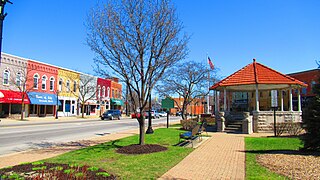
The Dundee Historic Village is a historic district located in Dundee, Michigan. The district was added to the National Register of Historic Places on August 20, 1990. This area is commonly referred to as the downtown area of Dundee and was settled almost concurrently with the Old Village Historic District in nearby Monroe. Both were built in their respective locations due to the River Raisin. Originally, the buildings within the district were small, wood buildings, but these were eventually replaced with two-story, brick storefronts. Most of the surviving buildings were built between 1866 and 1900, although the district traces its origins to Dundee's establishment in 1825.

The Old Mill Museum, also known as the Alfred Wilkerson Grist Mill, is a historic structure located along the River Raisin at 242 Toledo Street in Dundee, Michigan. It was designated as a Michigan Historic Site on August 3, 1979. It was later listed as a contributing property within the Dundee Historic District, which was added to the National Register of Historic Places on August 20, 1990.

The Bridge School is a former school building located in rural Raisinville Township in the U.S. state of Michigan. It is recognized as the first public school in the Territory of Michigan when it was founded in 1828. The school district closed in 1946, and the building has served as Raisinville Township Hall since 1982. The Bridge School was listed as a Michigan State Historic Site on December 17, 1987.





